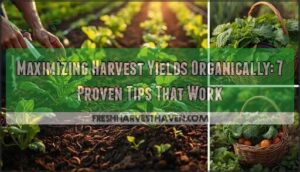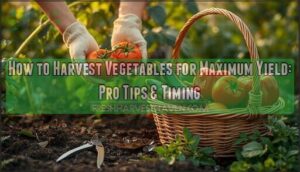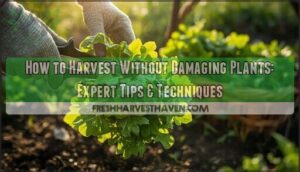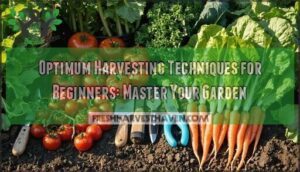This site is supported by our readers. We may earn a commission, at no cost to you, if you purchase through links.

Start with soil testing to identify pH levels and nutrient gaps, then apply compost to increase organic matter by 25%.
Implement crop rotation using legumes for nitrogen fixation, followed by leafy greens and root vegetables.
Deploy beneficial insects like ladybugs for natural pest control before resorting to organic sprays.
Install drip irrigation to cut water waste by 50% and use soil moisture sensors to prevent overwatering.
Choose disease-resistant varieties that mature early for potential double cropping.
These science-backed methods work together like pieces of a puzzle, creating sustainable productivity gains that protect your soil while maximizing returns.
Table Of Contents
- Key Takeaways
- Organic Farming Practices
- Choosing Crop Varieties
- Soil Quality Optimization
- Water Management Techniques
- Harvesting and Post-Harvest Handling
- Frequently Asked Questions (FAQs)
- Does diversification reduce organic to conventional yield gap?
- Can organic farming be improved and re-organized?
- How are crop yield and soil data analyzed?
- What is Hongyi organic farm?
- How do you improve soil fertility and reduce pest pressure?
- How to increase yield in organic farming?
- Does organic farming increase crop yields?
- How to maximize crop yield?
- How can we increase crop yields without damaging the environment?
- How can modern farming improve crop yields?
- Conclusion
Key Takeaways
- You’ll boost your organic yields by 15-35% through strategic soil testing and adding compost, which increases organic matter by 25% and creates the foundation for maximum plant productivity.
- You can cut water waste by 50% while improving plant health by installing drip irrigation systems paired with soil moisture sensors that prevent both overwatering and drought stress.
- You’ll naturally control pests and break disease cycles through smart crop rotation—starting with nitrogen-fixing legumes, followed by leafy greens, then root vegetables to maximize soil health and harvest potential.
- You can extend your growing season and increase total yields by choosing disease-resistant varieties that allow for double cropping and perform consistently in your local conditions, using early-maturing varieties.
Organic Farming Practices
You can boost your organic harvest yields by focusing on four core practices that work together like a well-oiled machine.
These proven methods—soil health management, smart crop rotation, natural pest control, and efficient water use—form the foundation of successful organic farming.
That delivers results season after season, utilizing efficient water use to maximize productivity.
Soil Health Management
Your soil serves as the foundation for thriving crops. Start with soil testing to identify pH levels and nutrient deficiencies.
Strong soil foundations create thriving crops—test first, then build with nature’s best amendments
Apply compost regularly to boost microbial diversity and enhance nutrient cycling. These organic amendments create an environment where beneficial microbes flourish, improving soil health management.
Balance soil pH through targeted amendments like lime or sulfur. Consistent compost application increases organic matter by 25%, supporting robust soil conservation techniques while optimizing organic fertilizer use for maximum harvest yields.
Effective sustainable agriculture practices are essential for maintaining healthy soil and maximizing crop yields.
Crop Rotation Strategies
Strategic crop planning transforms your garden into a powerhouse of productivity. Smart rotation schemes break pest cycles while renewing soil naturally.
Here’s how organic crop rotation maximizes yields:
- Legumes first – Fix nitrogen for heavy feeders
- Leafy greens next – Utilize stored nitrogen efficiently
- Root vegetables follow – Break up soil compaction
- Fruiting crops finish – Complete the renewal cycle
- Cover crops between – Protect and enrich soil
This farm diversity approach delivers harvest optimization through natural soil conservation techniques.
Integrated Pest Management
Integrated pest management combines biological control with strategic monitoring for effective natural pest control.
You’ll track pest populations, then deploy beneficial insects like ladybugs and parasitic wasps as your first defense.
Natural barriers and crop resistance varieties create protective foundations against infestations.
When needed, organic sprays provide targeted intervention without harming beneficial species.
This biological pest control approach reduces chemical dependency while maintaining robust pest management through nature’s own systems.
Water Conservation Methods
Water management transforms your organic farm’s productivity and sustainability.
Efficient irrigation systems cut costs while boosting plant health through targeted water delivery.
Smart water conservation protects your investment and environment:
- Drip irrigation reduces water waste by 50% while delivering moisture directly to root zones
- Rainwater harvesting captures free water during storms for drought periods
- Mulch conservation prevents soil moisture evaporation and regulates temperature
- Irrigation scheduling with soil moisture sensors prevents overwatering and maximizes water efficiency.
These water retention strategies improve your harvest while protecting natural resources.
Implementing effective organic summer gardening methods is essential for maintaining a healthy and productive garden.
Choosing Crop Varieties
You’ll want to select crop varieties that match your specific growing conditions and climate zone.
Research shows that choosing the right varieties can boost your organic yields by 15-25% compared to generic options.
Identifying High-Yield Varieties
Crop selection starts with smart seed quality checks and proven genetic potential.
Disease-resistant tomatoes like ‘Defiant PhR’ boost yield prediction by 25% in variety trials. Early-maturing grains allow double cropping for 35% more harvest yields organically.
High-yield varieties with nutrient efficiency need 25% less fertilizer while delivering consistent results. Choose varieties that match your climate and soil conditions for ideal crop yield optimization.
By considering factors like soil health preparation, gardeners can create a fertile ground for their crops to thrive.
Assessing Local Growing Conditions
Understand your land before planting anything. Climate assessment reveals temperature ranges and frost dates that determine planting windows.
Soil mapping through testing shows pH levels and nutrient content. Study local microclimates around your property—they create unique geographic factors affecting water drainage and pest pressure.
Regional weather patterns help predict seasonal challenges for better planning decisions.
Utilizing Crop Rotation Strategies
Your local growing conditions set the stage, but smart crop rotation strategies become your secret weapon for maximizing harvest yields organically.
This systematic approach to soil health management transforms your garden into a self-sustaining powerhouse through natural nutrient cycling.
Strategic crop rotation disrupts pest control challenges while promoting soil renewal across seasons.
Here’s how rotation drives yield optimization:
- Heavy feeders like tomatoes deplete nitrogen, followed by nitrogen-fixing legumes that replenish soil
- Root vegetables break up compacted soil, improving structure for shallow-rooted crops next season
- Brassicas naturally suppress soil-borne diseases that affect other plant families
- Cover crops protect and enrich soil between main growing seasons
This organic farming method mimics nature’s patterns, creating resilient growing systems that consistently outperform monoculture approaches.
Engaging With Local Agricultural Communities
Beyond choosing the right varieties, connecting with agricultural communities amplifies your organic success. Farmer networks provide hands-on knowledge about varieties that thrive locally. Local workshops teach region-specific techniques while agricultural events showcase proven methods.
Community outreach opens doors to cooperative farming opportunities. Join community supported agriculture programs for shared resources and knowledge. Access local seed banks for tested varieties that perform well in your area.
| Resource Type | Benefits | Examples |
|---|---|---|
| Farmer Networks | Variety recommendations, pest solutions | Regional grower associations |
| Local Workshops | Hands-on training, seasonal timing | Extension office classes |
| Agricultural Events | Equipment demos, technique sharing | County fairs, field days |
| Cooperative Marketing | Cost reduction, bulk purchasing | Seed cooperatives, shared equipment |
These connections create a support system that transforms isolated farming into collaborative success through locally sourced knowledge and farm to table partnerships.
Soil Quality Optimization
Your soil’s health directly determines your harvest success, and optimizing its quality can boost organic yields by 10-20% through proper pH balance and nutrient management.
You’ll need to focus on three key areas: maintaining ideal soil composition, building organic matter content, and ensuring adequate macronutrient availability for maximum plant uptake.
Soil Composition and PH Balance
Your soil’s foundation directly impacts harvest success. Soil composition includes texture, minerals, and living organisms working together. Most vegetables perform best when pH levels stay between 6.0-7.0, where nutrient availability peaks.
Soil testing reveals current conditions and guides improvement strategies. When pH strays outside optimal ranges, nutrient cycling slows down and microbial balance suffers. This affects soil fertility substantially.
Smart farmers use targeted organic amendments to fix imbalances:
- Test soil pH using digital meters for accurate readings
- Add lime to raise acidic soils or sulfur to lower alkaline conditions
- Incorporate compost to buffer pH fluctuations naturally
- Monitor conditions through regular testing every season
Think of pH as your soil’s thermostat—when it’s right, everything else follows. Proper organic matter integration keeps this system running smoothly while supporting beneficial microbes.
Organic Matter Content and Nutrient Uptake
Your soil’s organic matter content acts like a nutrient bank account that compounds over time. Boosting organic matter from 2% to 5% can increase nitrogen uptake by 72% while enhancing microbial diversity.
Soil microbes release nutrients through decomposition, creating steady nutrient cycling that feeds your crops continuously. Understanding soil organic benefits is vital for maximizing harvest yields.
| Organic Matter % | Nutrient Availability | Microbial Activity | Water Retention | Yield Impact |
|---|---|---|---|---|
| 1-2% | Poor | Low | Limited | Baseline |
| 3-4% | Moderate | Active | Good | +15% |
| 5-6% | High | Thriving | Excellent | +25% |
| 7-8% | Peak | Peak | Superior | +35% |
| 9%+ | Maximum | Intense | Outstanding | +40% |
Compost benefits extend beyond simple fertilization. When you add organic fertilizers like aged manure or compost, you’re feeding soil microbes that transform raw materials into plant-available nutrients. This microbial activity creates a self-sustaining system where nutrient management becomes easier over time.
Essential Macronutrients and Fertilization
Your plants feed on three primary macronutrients that fuel maximizing harvest yields organically. Smart nutrient management transforms average gardens into abundant harvests.
- Nitrogen Fixing – Compost and aged manure supply steady nitrogen for lush leaf growth
- Phosphorus Management – Bone meal delivers phosphorus for strong root systems and flower production
- Potassium Sources – Wood ash provides potassium for improved fruit development and disease resistance
- Organic Fertilizers – Balance soil fertility with natural amendments that release nutrients slowly
- Macronutrient Balance – Apply fertilization during active growing seasons for maximum uptake
Proper timing makes organic fertilizers work harder for you. Understanding organic fertilizer options is vital for maintaining soil health and maximizing yields.
Water Management Techniques
Water doesn’t just keep your crops alive—it’s the key to revealing their full potential.
You’ll learn how smart irrigation techniques and conservation methods can boost your organic yields by 15-27% while cutting water waste in half, which is a crucial aspect of conservation.
Drip Irrigation and Water Conservation
Why settle for wasteful watering when drip irrigation delivers precision? You’ll slash water usage by 30-50% while targeting plant roots directly.
Water conservation becomes effortless as this system eliminates runoff and evaporation. Rainwater harvesting pairs perfectly with drip systems for maximum water savings.
Smart irrigation management means healthier crops and lower bills through superior water retention. Effective summer garden irrigation systems are essential for maintaining healthy plant growth during hot months.
| Water Method | Efficiency Rate |
|---|---|
| Sprinklers | 65-75% |
| Drip Systems | 85-95% |
| Hand watering | 40-60% |
| Soaker hoses | 70-80% |
| Flood irrigation | 45-55% |
Soil Moisture Sensors and Irrigation Scheduling
Smart sensors replace irrigation guesswork with precision data.
These devices monitor moisture levels continuously, triggering automated watering when plants need it most.
Sensor technology achieves over 95% accuracy while cutting water use by 20-30%.
Smart irrigation transforms your garden from guesswork into a precision-fed paradise that thrives with every drop.
Here’s why soil moisture sensors revolutionize harvests:
- Prevent overwatering mistakes that drown roots and waste resources
- Catch drought stress early before permanent plant damage occurs
- Schedule irrigation timing perfectly using real data instead of assumptions
- Boost water efficiency substantially through targeted conservation methods
- Monitor multiple zones remotely without constant field visits
Position sensors at root depth for accurate readings.
Modern irrigation scheduling systems integrate seamlessly, creating automated programs that adjust based on actual soil conditions and weather forecasts.
By utilizing advanced soil moisture tools, farmers can optimize their irrigation strategies to achieve better crop yields.
Mulching and Rainwater Harvesting
Beyond sensors, organic mulching creates your garden’s best defense against water loss.
Apply 2-3 inches of mulch types like straw around plants to boost soil moisture retention by 50%.
Rainwater systems using barrels capture 600 gallons per roof inch, supporting water conservation goals.
These water efficiency strategies reduce irrigation needs while providing natural organic weed control benefits that cover crops and rainwater harvesting deliver year-round.
Efficient Irrigation and Water Retention
With precision irrigation, you’ll transform every drop into maximum plant growth.
Drip irrigation delivers water directly to root zones, cutting waste by 50% while boosting yields. Smart irrigation scheduling paired with soil moisture monitoring prevents both drought stress and waterlogged roots.
- Drip irrigation systems target root zones, eliminating surface evaporation losses
- Soil moisture sensors trigger watering only when plants need it most
- Water conservation through mulching techniques reduces irrigation frequency by 40%
- Rainwater harvesting supplements drip systems during peak growing seasons
This targeted approach maximizes water retention while maintaining consistent soil moisture levels for healthier, more productive plants.
Harvesting and Post-Harvest Handling
You’ve mastered growing organic crops, but the real challenge starts when it’s time to harvest.
Getting the timing right and handling your produce properly can mean the difference between maximum yields and disappointing losses.
Optimal Harvesting Techniques and Timing
Harvest timing directly impacts your crop monitoring efforts and yield optimization success.
Peak fruit ripening signals vary by crop—tomatoes show deep color while corn silk turns brown.
These timing strategies require daily observation during harvest season.
Optimal harvesting techniques protect your investment:
- Early morning collection: Cool air preserves cellular structure and extends storage life
- Sharp, sanitized tools: Clean cuts prevent disease entry points and tissue damage
- Gentle handling methods: Reduces bruising that leads to rapid deterioration and waste
Harvest scheduling based on visual cues maximizes crop yields.
Check firmness alongside color changes for accurate ripeness assessment.
Organic crop management demands this careful attention since you can’t rely on artificial ripening agents.
Timely harvesting captures peak nutrition and flavor profiles.
Post-Harvest Handling and Storage Methods
Success hinges on proper postharvest handling after your crops leave the field.
Cool produce immediately using ice baths or refrigeration to remove field heat.
Storage methods require controlled environments with proper ventilation for maximum shelf life. Quality control prevents damaged items from spoiling healthy stock during crop storage.
Processing and Preservation for Extended Shelf Life
Processing your fresh harvest correctly locks in quality preservation for months ahead.
Food Dehydration removes 80-90% moisture, preventing spoilage organisms from thriving.
Canning Methods using natural acids create shelf-stable products lasting twelve months.
Freeze Drying retains 95% of nutrients while Vacuum Packing eliminates oxygen exposure.
Fermentation Techniques naturally preserve while adding probiotics.
- Steam rising from blanched vegetables before freezing
- Glass jars lined up, sealed tight with golden preserves
- Dehydrator trays loaded with colorful fruit slices
- Fermentation crocks bubbling with active cultures
Best Practices for Harvesting and Storage of Different Crops
Your harvest timing determines everything.
Crop handling starts when you pick at peak ripeness – tomatoes slightly soft, carrots sweet after frost.
Each post harvest step matters for maximizing crop yields.
Use proper storage methods and crop packaging to prevent waste.
Smart harvesting techniques paired with crop rotation strategies and organic farming practices create a system that works.
Frequently Asked Questions (FAQs)
Does diversification reduce organic to conventional yield gap?
Absolutely transformative! You’ll slash the yield gap dramatically through diversification.
Research shows polyculture systems boost harvests by 22% over monocultures, while intercropping increases land-use efficiency by 15%.
Biodiversity creates resilient farms that outperform conventional methods consistently.
Can organic farming be improved and re-organized?
You can definitely improve organic farming through better organization and smarter techniques.
Crop rotation, cover cropping, and integrated pest management boost yields substantially.
Smart water systems and soil testing help optimize resources efficiently, which can be considered a key part of smarter techniques.
How are crop yield and soil data analyzed?
Like decoding a puzzle, you’ll analyze crop yield data through soil tests, harvest measurements, and statistical comparisons to identify patterns and optimize growing conditions for better results.
What is Hongyi organic farm?
You don’t have specific information about "Hongyi organic farm" available.
Hongyi Organic Farm was established in 2006 on 7 hectares of previously abandoned land, featuring 7 hectares of cropland .
This eco-farm model demonstrates efficient methods for both yield improvement and environmental benefits through innovative techniques.
How do you improve soil fertility and reduce pest pressure?
You’ll boost soil fertility by adding compost, rotating crops, and planting cover crops like legumes. Control pests naturally through beneficial insects, companion planting, and choosing disease-resistant varieties for healthier harvests.
How to increase yield in organic farming?
Good soil feeds the plant, great soil feeds the farmer.
You’ll boost yields by enriching soil with compost, rotating crops strategically, using drip irrigation, and encouraging beneficial insects through companion planting techniques.
Does organic farming increase crop yields?
Organic farming can increase yields through improved soil health, biodiversity, and natural pest control.
While initial yields may be lower, well-managed organic systems often match or exceed conventional yields over time, which can be considered a complete concept in the context of organic farming yields.
How to maximize crop yield?
Consider a farmer who doubled their tomato harvest by implementing soil testing and targeted amendments.
You’ll maximize yields by improving soil health through regular testing, strategic crop rotation, integrated pest management, and efficient water systems like drip irrigation.
How can we increase crop yields without damaging the environment?
You’ll increase yields by improving soil health through crop rotation, cover crops, and composting.
Use drip irrigation to conserve water while adding beneficial insects for natural pest control instead of chemicals.
How can modern farming improve crop yields?
You can boost crop yields by rotating crops strategically, improving soil health with compost, using precision irrigation, selecting disease-resistant varieties, and implementing integrated pest management systems.
Conclusion
Revolutionary changes await your garden when you apply these organic methods consistently.
Maximizing harvest yields organically isn’t just possible—it’s your pathway to sustainable abundance.
You’ll see dramatic improvements within one growing season by combining soil testing, crop rotation, and water management.
These proven techniques work together like clockwork.
Start with soil health first, then add irrigation improvements.
Your plants will reward you with bumper harvests year after year.












